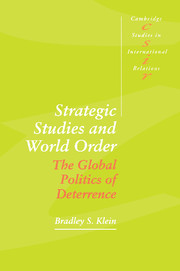3 - WHAT NUCLEAR REVOLUTION?
Published online by Cambridge University Press: 06 July 2010
Summary
A wall was erected between the dvil and the military, a wall which cut off all relations between them and shut them away from each other's view. And because the people on the inside of the wall were engaged in something which seemed mysterious to profane eyes, those on the outside considered that something beyond their comprehension and bowed to it with a respect almost religious.
(Giulio Douhet)The last chapter explored the political nature of strategic thought. In this chapter, attention focuses on nuclear deterrence. Arguments about the character of nuclear strategy have been decisively shaped by claims made nearly a half a century ago regarding a “revolution” in the nature of political-military strategy that was ushered in with the advent of the overwhelming offensive power of atomic and thermonuclear weaponry. This has been called the nuclear revolution, the absolute triumph of offense over defense, and with it a transformation of the nature of military force, from war-winning to war-prevention through deterrence. But such arguments are founded on technical understandings of military force abstracted from social purpose and cultural processes. In this chapter, I elaborate the Clausewitzian foundations of arguments about a nuclear revolution and criticize the “thin” accounts of politics, force, technology and revolution which animate such views in the first place. The result is an awareness of the rhetorical or representational practices by which Strategic Studies removes questions of organized violence from social practices.
To undertake that, I begin with a short account of realism, followed by a detailed account of the terms of nuclear “revolution.”
- Type
- Chapter
- Information
- Strategic Studies and World OrderThe Global Politics of Deterrence, pp. 39 - 80Publisher: Cambridge University PressPrint publication year: 1994

